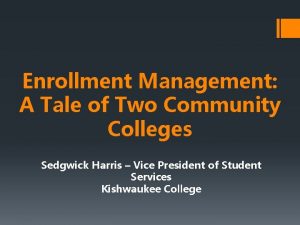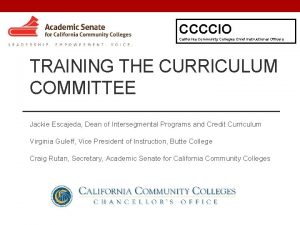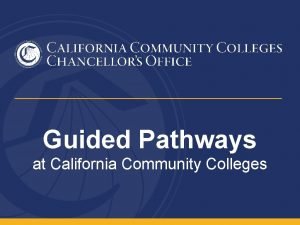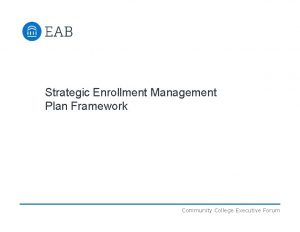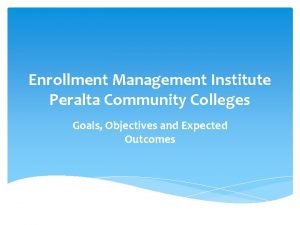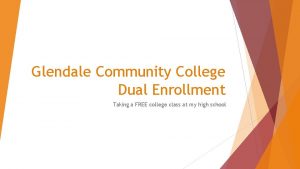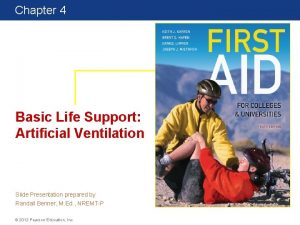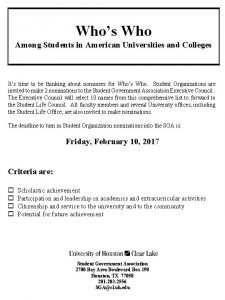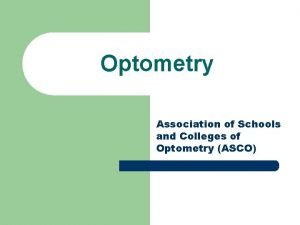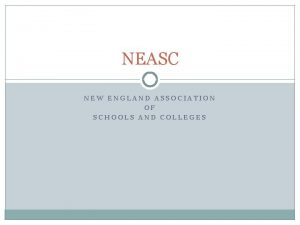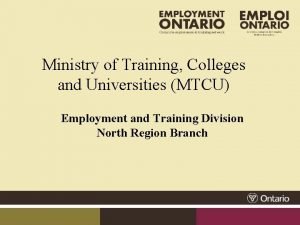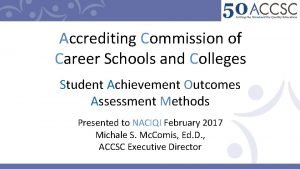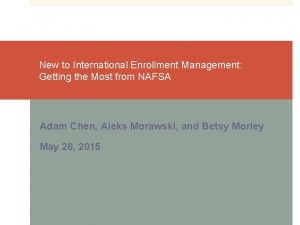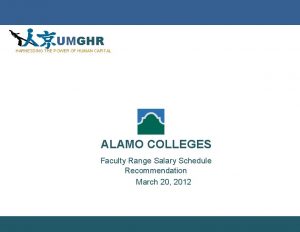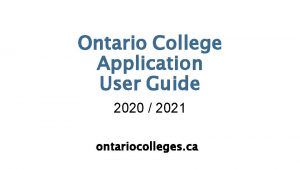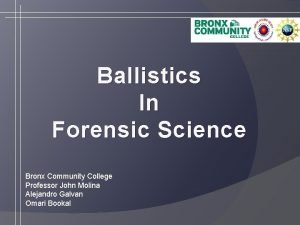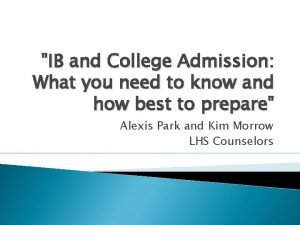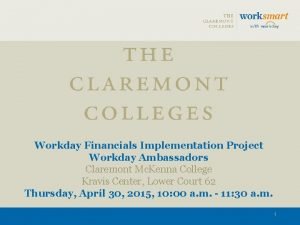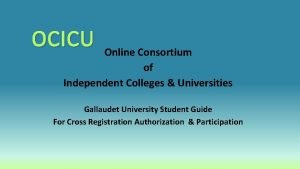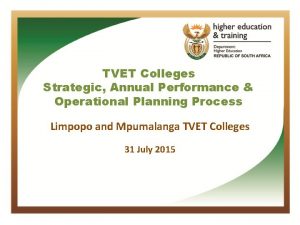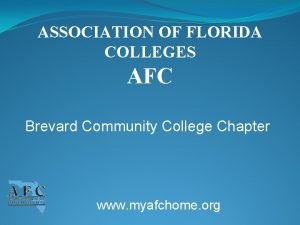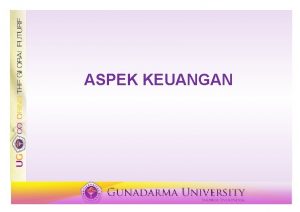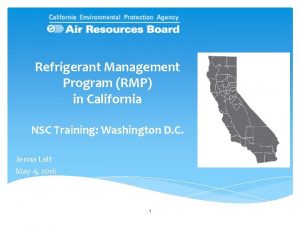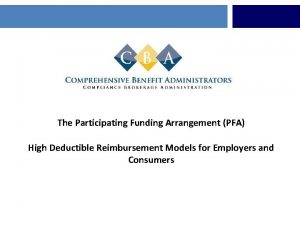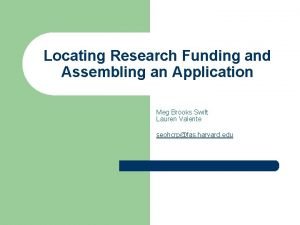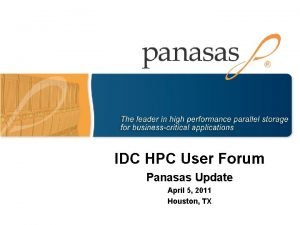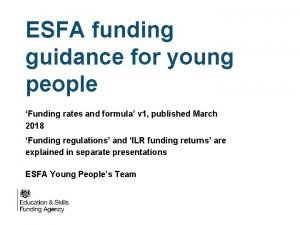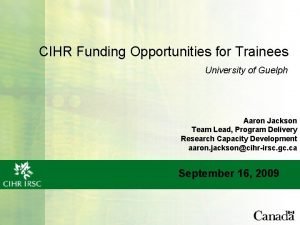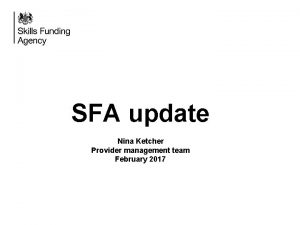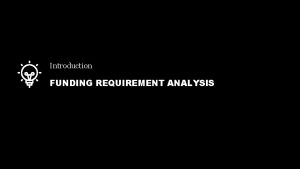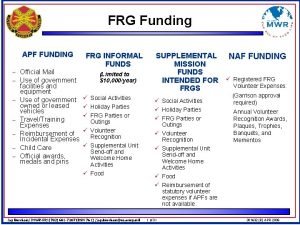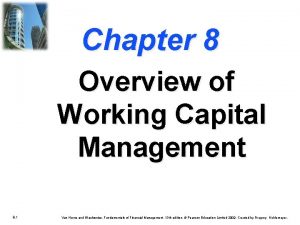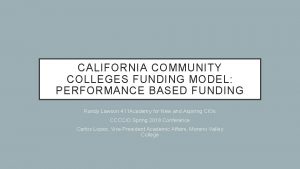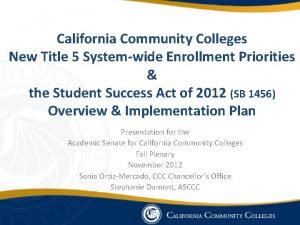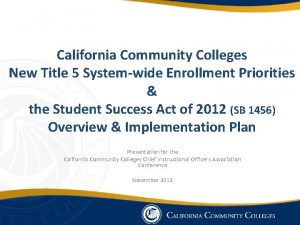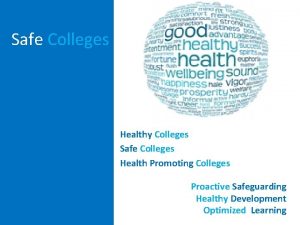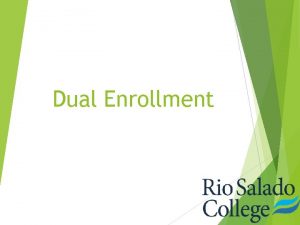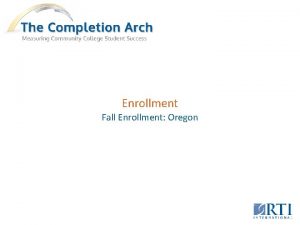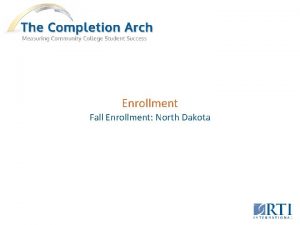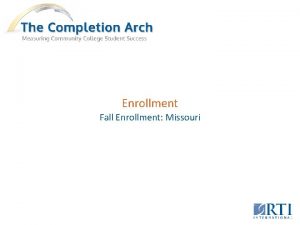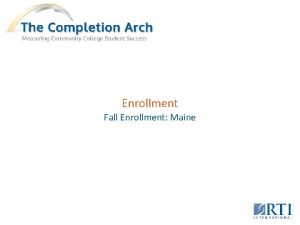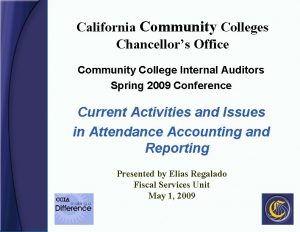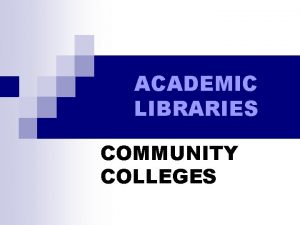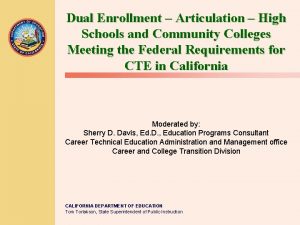California Community Colleges Funding and Strategic Enrollment Management







































































- Slides: 71

California Community Colleges Funding and Strategic Enrollment Management John Mullen Senior Consultant, Fiscal Services CCC Chancellor’s Office October 23, 2018 Randy Lawson CIO Leadership Institute 1

2

Vision for Success Goal 1: Increase by at least 20 percent the number of CCC students annually who acquire associates degrees, credentials, certificates, or specific skill sets that prepare them for an in-demand job. Goal 2: Increase by 35 percent the number of CCC students system-wide transferring annually to a CSU or UC, necessary to meet the state’s needs for workers with baccalaureate degrees. Goal 3: Decrease the average number of units accumulated by CCC students earning associates degrees from approximately 87 to 79 total units—the average among the top 5 th of colleges showing the strongest performance on this measure.

Guided Pathways Vision for Success Goal 4: Increase the percentage of exiting CTE students who report being employed in their field of study, from the statewide average of 60% to 69%--the average among the top 5 th of colleges showing the strongest performance on this measure. Goal 5: Reduce equity gaps by 40% across all of the previous measures through faster improvements among traditionally underrepresented students, closing the gap within 10 years. Goal 6: Reduce regional achievement gaps across the previous measures through faster improvements among colleges located in regions with the lowest educational attainment of adults, with the goal of closing the gap within 10 years.

IEPI Goals 1. Advance the California Community Colleges as the most effective and innovative system of higher education in the world. 2. Help colleges enhance student access, success, and equity. 3. Help colleges avoid accreditation sanctions and audit findings. 4. Support colleges in implementing emerging initiatives. 5

Q: How has Apportionment Revenue traditionally been allocated? A: On the basis of Full-time Equivalent Students (FTES) in attendance, as reported to the Chancellor’s Office on the CCFS-320 Report three times each year. 6

Full-Time Equivalent Student 1 FTES = 1 student 15 hours per week 2 semesters of 17. 5 weeks (3 quarters of 11. 75 weeks) = 525 contact hours 7

Full-Time Equivalent Student • A unit of measure based on hours of student attendance • Not a head count of students • Not based on the total number of units of credit in which students are enrolled 8

An Hour is An Hour • No, it’s actually 50 minutes • All hours of instruction are counted equally Ø Lecture Ø Laboratory Ø Activity 9

New Student Centered Funding Formula 10

Student Centered Funding Formula “…California’s state leaders have truly delivered on a promise to put students first and set an example for the rest of the nation by adopting a new funding formula that incentivizes student success…” –Chancellor Eloy Ortiz Oakley 11

Student Centered Funding Formula While the system has made significant strides in improving student success, serious challenges remain. • Most students who enter a community college never complete a degree or certificate or transfer. 12

Student Centered Funding Formula • Students who do reach an educational goal take a long time to do so. • Achievement gaps persist (across student groups and across regions). 13

Student Centered Funding Formula Discussions about a new funding formula began more than a year ago, given concerns among system stakeholders that enrollment—the traditional driver of funding—has been stagnant in many districts. 14

Student Centered Funding Formula In reforming funding for community college districts, the aim is to do the following: • Encourage progress toward the Vision for Success adopted by the Board of Governors. 15

Student Centered Funding Formula • Provide groups of students that have faced barriers to success with additional support to meet our goals. • Make resources most useful to community college districts by making them stable, predictable, and flexible. 16

Student Centered Funding Formula Community college finance should further the activities the Chancellor’s Office is undertaking through the Guided Pathways framework. 17

Student Centered Funding Formula The new formula calculates apportionments generally using three allocations: Base Allocation Supplemental Allocation Student Success Allocation 18

Student Centered Funding Formula Base Allocation—Current factors (primarily credit FTES). Supplemental Allocation—Counts of low-income students. Student Success Allocation—Counts of outcomes related to the Vision for Success, with “premiums” for outcomes of low-income students. 19

Student Centered Funding Formula Noncredit FTES (and some other FTES) will be funded at current rates. The rates are calculated to provide a three-year transition. 20

Student Centered Funding Formula For the Supplemental Allocation, a district will receive one “point” based on the counts of all of the following in the prior year: • Pell Grant recipients • California College Promise Grant recipients • AB 540 students 21

Student Centered Funding Formula For the Student Success Allocation, points are assigned on the basis of eight measures: 1. Associate degrees for transfer granted 2. Associate degrees granted (excluding ADTs) 22

Student Centered Funding Formula 3. Baccalaureate degrees granted 4. Credit certificates (16 units or more) granted 5. Completions of transfer-level mathematics and English courses within first academic year of enrollment 23

Student Centered Funding Formula 6. Successful transfers to four-year university 7. Completions of nine or more CTE units 8. Attainments of regional living wage 24

Student Centered Funding Formula Points assigned for each measure will be weighted as follows: 1. Associate degrees for transfer granted All students 4 Pell Grant Premium 4 Promise Grant Premium 6 25

Student Centered Funding Formula 2. Associate degrees granted (excluding ADTs) All students 3 Pell Grant Premium 3 Promise Grant Premium 4. 5 26

Student Centered Funding Formula 3. Baccalaureate degrees granted All students 3 Pell Grant Premium 3 Promise Grant Premium 4. 5 27

Student Centered Funding Formula 4. Credit certificates (16 units or more) granted All students 2 Pell Grant Premium 2 Promise Grant Premium 3 28

Student Centered Funding Formula 5. Completions of transfer-level mathematics and English courses within first academic year of enrollment All students 2 Pell Grant Premium 2 Promise Grant Premium 3 29

Student Centered Funding Formula 6. Successful transfers to four-year university All students 1. 5 Pell Grant Premium 1. 5 Promise Grant Premium 2. 25 30

Student Centered Funding Formula 7. Completions of nine or more CTE units All students 1 Pell Grant Premium 1 Promise Grant Premium 1. 5 31

Student Centered Funding Formula 8. Attainments of regional living wage All students 1 Pell Grant Premium 1 Promise Grant Premium 1. 5 32

Student Centered Funding Formula Point Values 2018 -19 Base Allocation Dollars per Credit FTES $ 3, 727 Basic Allocation TBD Supplemental Allocation - Dollars per point $ 919 Student Success Allocation - Dollars per point $ 440 Student Success Equity Allocation – Dollars per point $ 111 33

FTES Calculation o o o Clock Hour Class Hour Passing time/break Partial class hour Multiple hour class 34

Clock Hour A 60 -minute time frame that may begin at any time. Examples: 0800 to 0900 0810 to 0910 0820 to 0920 35

Class Hour o A period of not less than 50 minutes of scheduled instruction or examination o There can be only one “class hour” in each “clock hour, ” except as provided for multiple hour classes. 36

Class Hour o A “class hour” is commonly called a “contact hour” or “Student Contact Hour. ” 37

Passing Time/Break o Each clock hour is composed of one class hour segment and a segment referred to as “passing time” or a “break. ” o No additional attendance may be claimed for the 10 -minute segment, except for multiple-hour classes. 38

Multiple Hour Class o A multiple hour class is defined as a class scheduled for more than one clock hour. o The fractional part of a class hour at the end of a multiple hour class is called a partial class hour. 39

Multiple Hour Class o Each 50 minutes exclusive of breaks is a class hour. o A partial class hour beyond the last full clock hour is counted from the 51 st minute of the last full clock hour. 40

Multiple Hour Class o No break is allowed in the last full clock hour or the partial class hour. o The divisor for the partial class hour is 50. 41

Multiple Hour Class o Example: 7: 00 p. m. to 10: 05 p. m. PCH: 9: 51 – 10: 05 = 15 min. 15/50 = 0. 3 Total Contact Hours: 3. 3 42

Calculate the contact hours: Class meets from • 0900 to 0950 • 0900 to 1005 • 0900 to 1050 • 0900 to 1105 • 0900 to 1130 Contact hours 1. 0 1. 3 2. 0 2. 3 2. 8 43

Contact Hours Computation Table 44

Attendance Accounting Methods o Weekly Student Contact Hour o Daily Student Contact Hour o Actual Hours of Attendance (Positive Attendance) o Alternative Attendance Accounting Method (Independent Study/Work Experience) o Noncredit Distance Education 45

Weekly Student Contact Hour o Primary terms only o Course coterminous with primary term o Must meet regularly every week of the term o Same number of contact hours each week including TBA hours o No deductions for holidays 46

Census Week o The week nearest to 20% of the number of weeks in the primary term o Census date is Monday of census week o If that Monday is a holiday, census date is the following day 47

Term Length Multiplier o Number of weeks in primary term with at least three days of instruction and/or examination o The term length multiplier for each college is set by the CCC Chancellor’s Office based on the college’s academic calendar o Maximum TLM: 17. 5 for semesters 11. 67 for quarters 48

FTES Calculation (WSCH) o Multiply Census Week WSCH by the TLM and divide by 525 FTES = (CWSCH x TLM) / 525 Example: Class meets 3 hours/week 30 students enrolled on Census Day TLM = 17. 5 FTES = (3 x 30 x 17. 5) / 525 = 3. 00 49

Daily Student Contact Hour o Course meets five or more days o Meets the same number of hours on each scheduled day, including any TBA hours o NOT coterminous with primary term o No hours counted for holidays 50

Census Day o The day of the class meeting that is nearest 20% of the number of days the course is scheduled to meet o When the census day falls on the first day the class meets, census is taken on the second day. 51

Course Length Multiplier o Number of days the course is scheduled to meet (CLM) 52

FTES Calculation (DSCH) o Multiply Census Day DSCH by the Course Length Multiplier and divide by 525 FTES = (CDSCH x CLM) / 525 Example: Course meets 2 hours per day 30 students enrolled on Census Day Course meets on 24 days FTES = (2 x 30 x 24) / 525 = 2. 74 53

Positive Attendance o Based on actual count of enrolled students present at each class meeting o Courses meeting fewer than five days o Courses irregularly scheduled with respect to the number of days per week or the number of hours on scheduled days o All noncredit courses 54

FTES Calculation (PA) o Divide total hours of actual attendance by 525 FTES = PAH / 525 55

Maximizing FTES Yield for Traditional (Face-to-Face) Classes Best: Weekly Census Second Best: Daily Census Worst: Positive Attendance 56

Scheduling Exercise • ENGL-107 Six Week Summer Session Proposed Schedule: Lecture MTWTh 8: 00 – ? ? • Catalog calls for 3 lecture hours per week, or 3*18 = 54 total contact hours. • Class has 23 MTWTh meeting days. • 54/23 = 2. 3 contact hours per day • Correct schedule: MTWTh 8: 00 – 10: 05 57

Scheduling Exercise • BIOL-103 A Six Week Summer Session Proposed Schedule: Lecture MTWTh 8: 45 – 11: 00 Lab MTW 11: 00 – 14: 00 • This configuration does not qualify for Daily Census since the meeting times vary on different days. Would have to be Positive Attendance, and that is undesirable. 58

Scheduling Exercise • BIOL-103 A Six Week Summer Session Catalog: 54 hours lecture, 54 hours lab Total hours: 108 Meeting days: 23 108/23 = 4. 7 or 4 hours, 25 minutes Solution: MTWTh 8: 00 – 12: 25 23 * 4. 7 = 108. 1 contact hours, distributed between lecture and lab 59

Working Together An Important Partnership • Instruction Office/Divisions/Departments Develop Schedule of Classes Build Sections in Computer • Admissions & Records Manage Admissions and Registration Attendance Reporting by Faculty 60

The Role of IT • • Essential Technical Support Maintain Hardware and ERP Software Ensure Data Integrity and Security Control Access to Data Support Users Assist Users in Understanding System Troubleshoot Problems 61

Curriculum Alignment CONSISTENCY is the magic word: • Catalog • Course Outlines of Record • Schedule of Classes – Printed Version • Online Class Listings • Class Syllabi 62

Alternative Attendance Accounting Method (Independent Study/Work Experience) o WSCH method for courses coterminous with primary term o DSCH method for all other courses 63

Alternative Attendance Accounting Method (Independent Study/Work Experience) o One weekly student contact hours is counted for each unit of credit for which the student is enrolled as of the census date or day. o Lab hours, when appropriate, can be added to the contact hours derived from units of credit 64

FTES Calculation (ISWE) o Until 2002, all distance education courses had to be assigned to the Independent Study/Work Experience attendance accounting method. o Current regulations allow any appropriate accounting method to be used for distance education courses. 65

Distance Education (Credit) o Multiply number of students enrolled as of census by the number of “weekly contact hours”; multiply by the Term Length Multiplier; divide by 525. FTES = (# Students x “WCH” x TLM) / 525 66

Full-Time Equivalent Student (FTES) Reporting Periods First Period: July 1 – December 31 Second Period: January 1 – April 15 Third Period: April 16 – June 30 Reports due: January 15 April 20 July 15 67

When to Report a Section o Attendance for weekly and daily census sections is reported in the period in which the census date falls. o Attendance for positive attendance sections is reported in the period in which the last class meeting occurs. 68

When to Report a Section o Summer Shift Exception: Attendance for daily census sections with census date before July 1 and ending date after July 1 may be reported in either fiscal year. 69

Frequently Observed Errors o Hybrid courses inappropriately assigned to the Weekly Census or Daily Census method o Daily Census courses with “weekly” lab hours o Summer courses assigned to Weekly Census o Summer courses reported in the wrong year, or reported in both years o Catalog hours reported rather than Schedule hours o TBA hours irregularities 70

Questions? John Mullen Senior Consultant, Fiscal Services California Community Colleges Chancellor’s Office jmullen@cccco. edu Mobile: (650) 533 -6850 71
 Community colleges
Community colleges California community college chief instructional officers
California community college chief instructional officers Chief instructional officers california community colleges
Chief instructional officers california community colleges Guided pathways california community colleges
Guided pathways california community colleges Enrollment management plan template
Enrollment management plan template Washington state board of technical and community colleges
Washington state board of technical and community colleges Community education and training colleges
Community education and training colleges Community colleges
Community colleges Association of canadian community colleges
Association of canadian community colleges Io model strategic management
Io model strategic management Cultural aspects of strategy choice
Cultural aspects of strategy choice Glendale community college enrollment
Glendale community college enrollment Strategic complements and substitutes examples
Strategic complements and substitutes examples Ccap california community college
Ccap california community college World federation of colleges and polytechnics
World federation of colleges and polytechnics Pearson
Pearson Styria colleges and universities
Styria colleges and universities Ufa colleges and universities
Ufa colleges and universities Chelyabinsk colleges and universities
Chelyabinsk colleges and universities Chon buri colleges and universities
Chon buri colleges and universities Yaroslavl colleges and universities
Yaroslavl colleges and universities Who's who among american college students
Who's who among american college students Association of schools and colleges of optometry
Association of schools and colleges of optometry New england association of schools and colleges
New england association of schools and colleges Mtcu ontario
Mtcu ontario Accrediting commission of career schools and colleges
Accrediting commission of career schools and colleges Application management certificate
Application management certificate International enrollment management
International enrollment management Strategic fit vs strategic intent
Strategic fit vs strategic intent Alamo colleges faculty salary schedule
Alamo colleges faculty salary schedule Ontario college application
Ontario college application Alamo colleges 1098 t
Alamo colleges 1098 t Brevet des colleges
Brevet des colleges Colleges for forensic ballistics
Colleges for forensic ballistics Ib friendly colleges
Ib friendly colleges Restoration movement colleges
Restoration movement colleges Workday claremont colleges
Workday claremont colleges Ocicu courses
Ocicu courses Kegiatan menulis di perguruan tinggi
Kegiatan menulis di perguruan tinggi Different types of colleges
Different types of colleges Northern ireland colleges
Northern ireland colleges Claremont colleges sakai
Claremont colleges sakai Tvet colleges limpopo
Tvet colleges limpopo Forprofit colleges
Forprofit colleges Association of florida colleges
Association of florida colleges Funding and tenders portal
Funding and tenders portal Kebutuhan dana
Kebutuhan dana California refrigerant management program
California refrigerant management program California geologic energy management division
California geologic energy management division Community action cycle
Community action cycle Small and light fba
Small and light fba Azure overage charges
Azure overage charges Participating funding arrangement
Participating funding arrangement Marcus scheuren
Marcus scheuren Harvard hcrp funding
Harvard hcrp funding Panasas funding
Panasas funding Garuda aerospace private limited
Garuda aerospace private limited Funding guidance for young people
Funding guidance for young people Cihr funding opportunities
Cihr funding opportunities Cape funding list
Cape funding list Unit 5 operating your business lesson 1 funding sources
Unit 5 operating your business lesson 1 funding sources Apprenticeship funding bands
Apprenticeship funding bands Unlimited funding
Unlimited funding Ken emond
Ken emond Apprenticeship technical funding guide
Apprenticeship technical funding guide Paintcollar funding
Paintcollar funding Funding needs example
Funding needs example Apf funding
Apf funding Vina meaning in vietnam
Vina meaning in vietnam Product funding model
Product funding model Funding requirements example
Funding requirements example Funding needs example
Funding needs example
